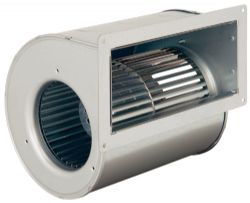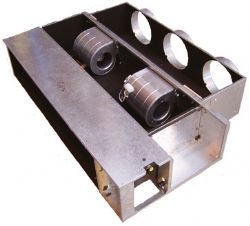The case for using EC fans in fan coil units instead of AC has long been accepted when it comes to new-build projects. But what about retrofit? Robert Harness has the answer

FAN COIL UNITS are a simple but effective means of air conditioning, which are unseen by building occupants. Apart from occasional filter changes, they rarely get a thought from facilities and energy managers as the fans tick over reliably at low speed. This is a classic case of out of sight, out of mind. However, the down side to this is that, unlike the lights burning brightly in every office, the amount of energy consumed doesn't get much thought either.
A typical AC fan coil unit may have three fans in it, each burning around 70 watts of electricity for up to 12 hours a day. A modest sized three-storey office building could have around 100 fancoil units on each floor so the total power input would be 63kW. That's an annual consumption of 189,000 kWh costing more than £18,000 in electricity, at today's prices. Yet despite these stark figures, very few building occupiers consider trying to reduce this consumption.
The case for using EC fans in fan coil units instead of AC has long been accepted when it comes to new-build projects. Energy savings of up to 80 per cent have been claimed, taking into account their advanced controllability and ability to match performance closely to demand. But is it a viable proposition to replace the AC fans in existing units with an EC alternative and what are the potential obstacles?
Practically speaking, there are no issues. Where separate blowers are used, you'd be hard pressed to spot the difference between the two types. An EC blower has identical dimensions to its AC counterpart. There may be a small amount of re-engineering required where a fan deck is used, but this is almost insignificant. As for the electrical connections, the bird's nest of wiring surrounding a multi-tapped transformer is totally done away with. Unlike their AC counterparts, EC fans provide built-in speed control accessed by a simple 0-10V DC input from the BMS system or by regulating the fan's own 10V output via a low cost potentiometer. It's also possible to take advantage of the EC fan's speed output signal to incorporate a fan fail alarm.
Having discounted any technical obstacle, cost and payback rightly become the main issue - but this is not really a black and white decision. There are many variable factors to consider - not least being what is an acceptable payback? To a large extent this will depend on the particular situation. It could be a building refurbishment where there is a consideration of whether to upgrade or replace the units, or a need to meet corporate targets for carbon reduction. In each case the financial justification will be different - I have outlined the main points that need to be considered when making this decision below.
Installation costs: This is going to be the biggest single cost factor, but does it have to be included in the payback calculation? Where a full refurbishment is undertaken, this cost would be offset by any alternative option and therefore may work in favour of a simple fan upgrade. This would not be the same for an occupied building. That said the replacement activity is not necessarily additional work. Depending on the duty hours and general conditions of operation, fancoil blowers will start to fail after about five years' service. At that point the fan has to be replaced. This activity has roughly the same labour content irrespective of whether an AC or an EC replacement is used. Therefore the EC upgrade labour element, created through on-condition maintenance or planned replacement, could reasonably be considered as cost neutral.
Parts costs: EC fans cost more than AC fans because of the inclusion of advanced on-board technology that gives them their high efficiency and integrated speed control. However, as with any product, cost is relative to demand. The EC fan coil revolution has meant that these fans are produced in high volume and at a lower relative cost than other EC fans. It is also important to consider that the cost of fans bought individually as replacement parts is considerably higher than when contracting for a refurbishment or retrofit project which will bring the AC and EC prices much closer together.

Asset value: A further consideration that many may overlook is the increased asset value of your building as a result of installing EC. This technology will use around half the electricity of AC, offer a considerably quieter solution, provide an infinite level of control and facilitate remote monitoring capability, quickly and simply linking into a wider building management system. When you look at this
in conjunction with an expected life span of at least five years, but predicted to be more, it considerably enhances the desirability and value of the property.
As energy prices and carbon taxes increase, paybacks become shorter and in some cases these can already be under two years, which is an excellent return on investment when considered against the strong long-term savings. Whatever your parameters for a sustainable business case, it's clear that you shouldn't ignore these hidden energy burners and an informed decision should be made as to their future.
// The author is business development manager of ebm-papst //